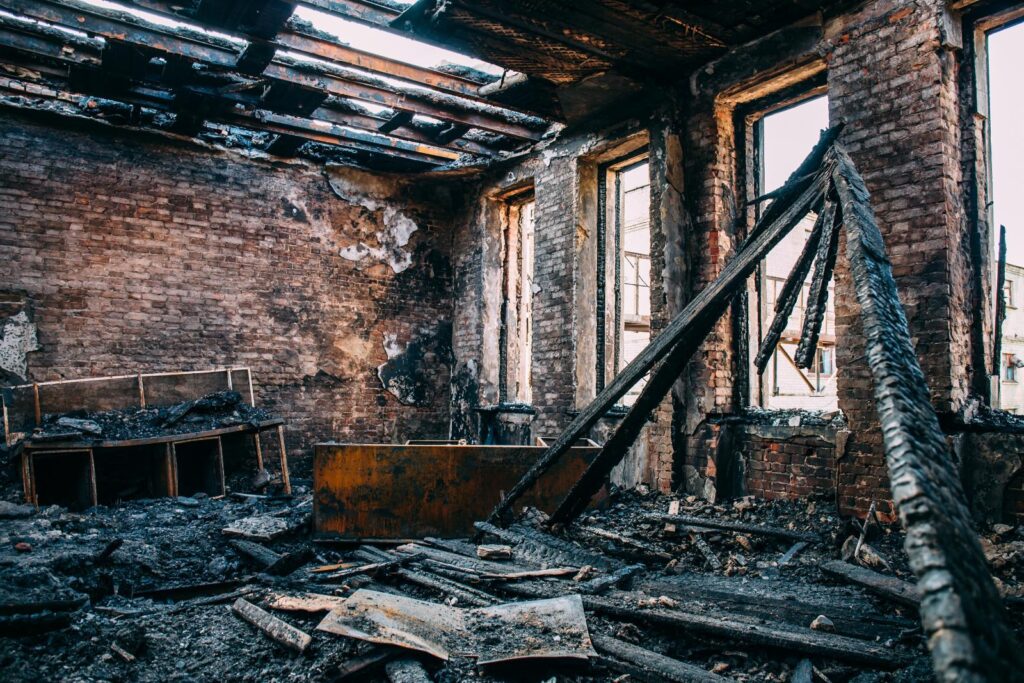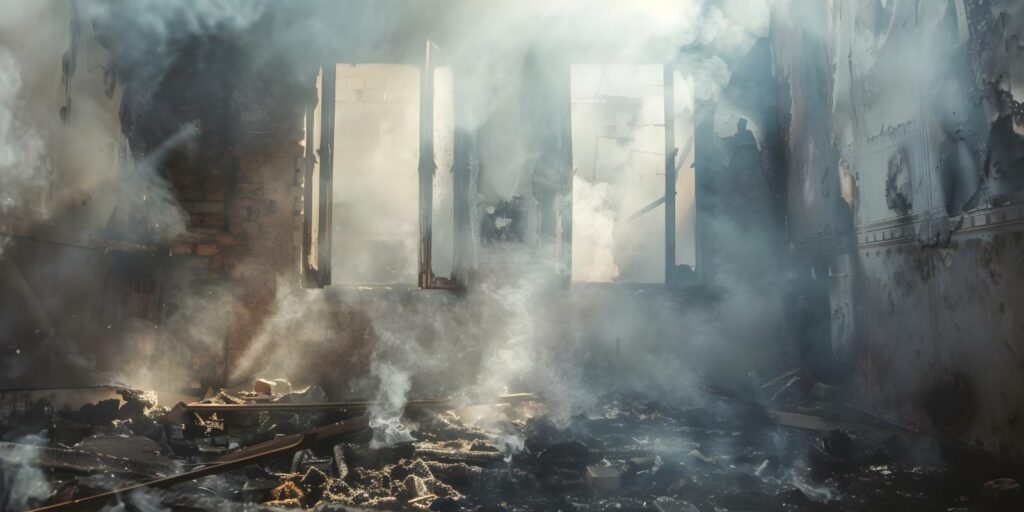
Contents
When you face the aftermath of a fire, it’s crucial to approach the damage cleanup process methodically and safely. You’ll want to start by assessing the damage, ensuring you’re aware of any potential hazards. Wearing the right protective gear and documenting everything with photos can set a solid foundation for your efforts. But there are specific techniques and tools you need to know about to effectively tackle soot, odors, and water damage. Understanding these methods can make a significant difference, especially when you consider the complexities involved…
Key Takeaways
- Conduct a thorough assessment of damage, documenting visible destruction and inspecting structural integrity of ceilings, walls, and floors.
- Prioritize safety by using personal protective equipment and ensuring proper ventilation in the workspace.
- Gather essential cleanup supplies, including HEPA vacuums, cleaning agents for fire damage, and tools for removing standing water.
- Use effective techniques to remove soot and odors, such as vacuuming with a HEPA filter and applying vinegar solutions.
- Know when to call professionals if damage is extensive, hazardous materials are present, or persistent smoke odors remain.
Assessing Fire Damage
After a fire, assessing the damage is crucial to determine the extent of repairs needed. You’ll want to conduct a thorough damage evaluation to identify all affected areas of your property. Start by documenting the visible destruction; take photographs of charred walls, ruined furniture, and damaged structural elements. This will serve not only as a record for insurance purposes but also as a basis for your property assessment.
As you examine the interior, pay close attention to the ceilings, walls, and floors. Look for signs of structural integrity issues, such as warping or sagging. Don’t forget to check for hidden damage behind walls or within electrical systems, as smoke and heat can affect areas not immediately visible. If you smell smoke or see discoloration, it’s a sign that the damage may be more extensive than it appears.
Next, assess the exterior of your property. Inspect the roof, siding, and foundation for any signs of fire damage. Look for melted materials, broken windows, or compromised support structures. Document everything meticulously, as this information will help you prioritize repairs and communicate effectively with professionals if needed.
Finally, consider the impact of smoke damage on your belongings. Smoke can penetrate deeply into fabrics and porous materials, leading to lingering odors. A comprehensive damage evaluation will guide you in deciding what can be salvaged and what needs replacement.
This proactive approach not only facilitates repairs but also helps restore your sense of belonging in your space.
Safety Precautions to Follow
When beginning the cleanup process following a fire, it’s essential to prioritize safety to protect yourself and others. Start by assessing your environment for potential hazards. Fire can weaken structural elements, so look for signs of instability in walls, ceilings, and floors before entering. If you notice any damage, it’s best to consult a professional before proceeding.
Using personal protective equipment (PPE) is crucial. Wear gloves, goggles, and a mask to shield yourself from soot and harmful particles. These items not only enhance your fire safety but also minimize exposure to residual toxins that may linger after a fire.
Maintain hazard awareness throughout the cleanup. Check for electrical hazards by ensuring the power supply is turned off at the main breaker. If you’re unsure, it’s better to wait for an electrician to assess the situation.
Also, be cautious of hazardous materials, such as asbestos or lead paint, which may have been disturbed during the fire.
Ensure ventilation in your workspace. Open windows and doors, and use fans to circulate air, reducing inhalation risks. If there’s heavy smoke damage, consider using an air purifier equipped with a HEPA filter.
Lastly, never attempt to clean up hazardous materials without proper training and equipment. Know your limits, and don’t hesitate to call in professionals for help if the situation seems overwhelming.
Essential Cleanup Supplies
To effectively tackle fire damage cleanup, you need to gather essential supplies that prioritize safety and efficiency.
Start with protective gear like gloves, masks, and goggles to shield yourself from hazardous materials.
Next, equip yourself with specialized cleaning tools designed to address soot, smoke residue, and structural debris.
Protective Gear Necessities
Safety is paramount during fire damage cleanup, and having the right protective gear is essential for minimizing health risks.
You’ll encounter various hazardous materials, including soot, ash, and potentially toxic fumes. Equipping yourself with the appropriate gear can greatly reduce your exposure to these dangers.
Here’s a list of essential protective gear to consider:
- Glove Types: Choose heavy-duty gloves made from nitrile or rubber to protect your hands from sharp debris and harmful chemicals.
Avoid thin latex gloves, as they won’t provide the necessary protection.
- Respirator Masks: A quality respirator mask is crucial for filtering out harmful particles and fumes.
Opt for masks with a P100 rating, as they can effectively block smoke and other airborne contaminants.
- Safety Goggles: Protect your eyes from dust and debris with sturdy safety goggles.
Make sure they fit well to prevent any particles from getting in.
Cleaning Tools Overview
Having the right cleaning tools is critical for effectively managing fire damage cleanup. First, you’ll need heavy-duty cleaning supplies, including scrub brushes, sponges, and microfiber cloths, which excel in applying various cleaning techniques to remove soot and residue.
A high-efficiency particulate air (HEPA) vacuum is essential for capturing fine particles that other vacuums might miss.
Don’t forget to equip yourself with buckets, spray bottles, and mops for efficient application of cleaning solutions. A pressure washer can also be invaluable for exterior surfaces.
Ensure you have a selection of cleaning agents formulated specifically for fire damage, such as degreasers and enzymatic cleaners.
Tool maintenance plays a large role in ensuring your cleanup goes smoothly. Regularly check and clean your tools to prevent cross-contamination and ensure optimal performance.
For instance, after using brushes or cloths, rinse them thoroughly to remove soot and ash, allowing them to dry completely before storage.
Removing Soot and Smoke
Soot and smoke residue can wreak havoc on your home after a fire, leaving behind unsightly stains and lingering odors. Tackling this damage effectively is crucial for restoring your space and ensuring a safe environment. Here are some essential soot removal techniques that can guide you through the process:
- Vacuum with a HEPA filter: This helps capture fine soot particles without spreading them further.
- Use a dry-cleaning sponge****: This specialized sponge lifts soot gently from surfaces, minimizing damage.
- Apply a mixture of water and vinegar**: This natural solution can neutralize odors** while cleaning surfaces.
When dealing with smoke damage, remember that prevention is key. The sooner you start the cleanup, the better your chances of minimizing damage.
Begin by ventilating your space; open windows and doors to let fresh air circulate. It’s also wise to cover furniture and floors to protect them from additional soot buildup.
As you work through the cleanup, always wear protective gear, including masks and gloves, to safeguard your health from harmful particles.
If the soot is extensive, you may consider consulting a professional service specializing in fire damage restoration. They can ensure a thorough job and help with smoke damage prevention measures for the future.
Addressing Water Damage
After a fire, addressing water damage is crucial to prevent further deterioration.
First, identify all potential water sources, including hoses or sprinkler systems that may have activated.
Next, implement effective drying and dehumidifying techniques to eliminate moisture and reduce the risk of mold growth.
Identify Water Sources
Identifying water sources is crucial in addressing water damage that often accompanies fire incidents. Water can enter your space from various points, and pinpointing these sources is essential for effective cleanup.
Start by conducting thorough moisture detection throughout the affected area.
Look for common water sources, such as:
- Burst pipes: Inspect plumbing for leaks or breaks, especially if the fire damaged surrounding structures.
- Roof leaks: Check for any gaps or breaches in the roof where rainwater could seep in.
- Firefighting efforts: Consider the amount of water used during firefighting, which may have pooled in certain areas.
Once you’ve identified these water sources, document their locations and severity. This information will guide your next steps in cleanup and restoration.
Remember, ignoring water damage can lead to mold growth and further structural issues. By tackling these water sources early, you’re not just protecting your property but also fostering a safer environment for you and your loved ones.
Stay vigilant, work methodically, and don’t hesitate to seek professional help if needed. Your proactive approach is key to restoring your space effectively.
Drying and Dehumidifying Techniques
Effective drying and dehumidifying techniques are essential in mitigating water damage following a fire incident. Start by assessing the extent of water intrusion and remove any standing water using a wet/dry vacuum.
Next, choose appropriate drying methods. Air movement is crucial; utilize fans and open windows to enhance circulation. If conditions allow, sunlight can naturally aid in drying.
You’ll also need to consider dehumidifier types. Refrigerant dehumidifiers are effective in warmer environments, while desiccant dehumidifiers excel in cooler conditions. For significant water damage, industrial-grade dehumidifiers are recommended, as they can remove large volumes of moisture quickly.
Monitor humidity levels using a hygrometer; keeping levels below 50% is ideal to prevent mold growth. Remember, drying materials thoroughly—like walls, carpets, and furniture—is vital, as residual moisture can lead to further damage.
Finally, ensure proper ventilation throughout the process. Combining these drying methods with the right dehumidifier types will help you restore your space effectively and efficiently, creating a safer, healthier environment for you and your loved ones.
Dealing With Odors
When tackling fire damage cleanup, addressing the lingering odors is crucial for restoring a clean environment. The smell of smoke can permeate your belongings, leaving you with an unwelcome reminder of the incident. To effectively eliminate these odors, you’ll need to utilize odor neutralizers and employ smoke absorption techniques.
Start by ventilating the area. Open windows and doors to create airflow, which helps dissipate the smoke odor.
Next, consider these effective methods:
- Activated charcoal: Place bowls of activated charcoal around the affected space. Its porous structure effectively absorbs smoke particles and odors.
- Baking soda: Sprinkle baking soda on carpets, upholstery, and other fabrics. Allow it to sit for several hours before vacuuming. Baking soda is a powerful odor neutralizer and can lift stubborn smells.
- Vinegar: Fill bowls with white vinegar and place them strategically throughout the room. Vinegar neutralizes odors and can help reduce the smell of smoke.
For tougher odors, you might need to invest in commercial odor neutralizers. Look for products specifically designed for smoke absorption, as they can penetrate surfaces and eliminate odors at their source.
As you work through this process, keep in mind that it may take time for the odors to dissipate completely. Be patient and persistent.
When to Call Professionals
Deciding whether to handle fire damage cleanup yourself or call in professionals can be challenging. It’s essential to assess the damage severity to make an informed decision. If you notice significant structural damage, such as compromised walls or ceilings, it’s a strong indicator for professionals.
Structural integrity is crucial for safety, and only trained experts should evaluate and manage repairs.
Another important factor is the presence of hazardous materials. If the fire involved chemicals or electronics, toxic residues may remain, posing health risks. In such cases, professionals have the right equipment and expertise to handle these dangers safely.
Additionally, if you’re experiencing persistent smoke odors or soot that doesn’t respond to DIY methods, it’s time to call in the experts. They utilize specialized techniques and products to eliminate odors and restore indoor air quality effectively.
You should also consider the size of the affected area. If the damage is extensive—affecting multiple rooms or levels—professional assistance is necessary.
Large-scale cleanup efforts require specialized equipment and manpower that you may not have access to at home.
Finally, if you find yourself feeling overwhelmed or unsure about the process, seeking professional help can provide peace of mind. Remember, safety should always come first.
Recap
As you navigate the aftermath of fire damage, think of yourself as a phoenix rising from the ashes. By carefully assessing damage, prioritizing safety, and using the right tools, you can reclaim your space and restore its former glory. Remember, however, that some fires leave scars too deep for DIY methods alone. If the cleanup feels insurmountable, don’t hesitate to call in professionals. They’re the guiding light that can help transform your home back into a sanctuary.



